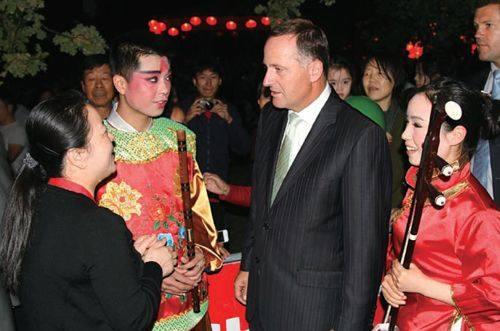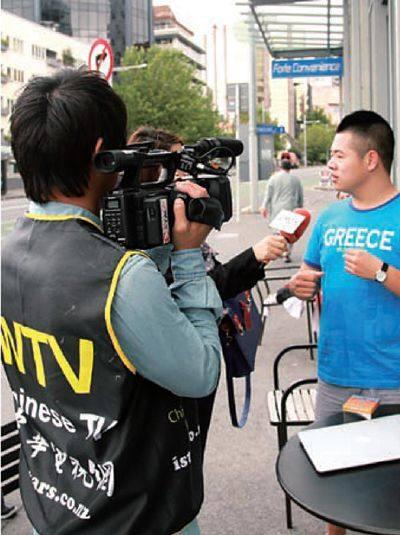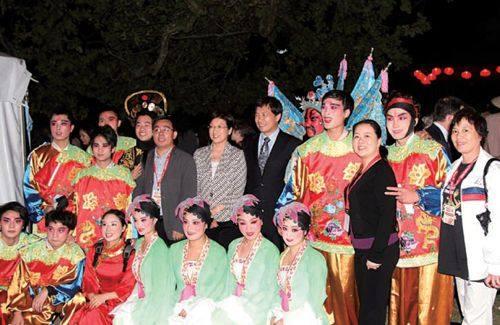台州乱弹“花开”新西兰
2012-04-29陈敢
陈敢



新西兰总理约翰•基与台州乱弹剧团部分演职人员交谈。Prime Minister of New Zealand John Key chats with some Luantan artists.
2月的新西兰正值夏日,入夜,上千盏彩灯将奥克兰市阿尔伯特公园装扮得流光溢彩,当地民众三五成群结伴徜徉其间,赏花灯、品美食、观表演,亲身感受正在这里展演的中国传统文化。
按照文化部部署和省、市的安排,受新西兰亚洲基金会的邀请,浙江省台州乱弹剧团15名演员参加了新西兰元宵灯会。在2月3日至5日的奥克兰元宵灯会和2月11日至12日的基督城元宵灯会上,台州乱弹以华丽的服饰、精湛的演技、热闹的场景获得观众热烈的掌声,共吸引了30余万人次前来观赏。
追着演员看演技
在新西兰元宵灯会上,浙江台州乱弹剧团技艺和上海“三林龙狮队 ”的舞龙表演,将中国南方戏曲与杂技交融,极富喜庆色彩;北京的龙神道摇滚乐队以及奥克兰本地的艺术团体和个人也纷纷登台献艺。中国文艺团体为游客们献上了一
SPECIALS特别报道
台包括民族舞蹈、地方戏曲、现代音乐、中国民乐等各式节目的多彩晚会。
在首场4个半小时的演出间隙,新西兰总理约翰 •基、中国驻新大使徐建国等新西兰各界名流看望了台州乱弹的代表团全体人员。约翰 •基总理还向大家恭贺新年,并高度评价华人社区为新西兰社会所作出的重要贡献。
身为浙江老乡的徐建国大使在认真听取关于台州乱弹的介绍后,高兴地说,随着中新文化交流日趋频繁,新西兰元宵灯会越来越受到当地主流社会欢迎,台州乱弹这样的文化项目到灯会上演出,很好地推动了中国文化和西方文化的融合。
参加表演的台州乱弹剧团副团长朱锋深有感触地说,每场演出完毕,总有不少新西兰民众兴致勃勃地跑到后台,追着演员看服饰,比划着动作学演技。更有不少家庭还跟着中国文艺团体从奥克兰到基督城,观看每一场演出。他们在草地上或广场中铺上一块布片,席地而坐,或自带板凳结伴观看,场景十分感人。
24岁的演员叶省委,身高虽然只有1.66米,但他表演的耍牙节目,却让观众敬佩不已,几乎每场表演一结束,就有好奇的大人、小孩追到后台,要求再表演一段。
其实,他表演的是将几颗五六厘米长的公猪牙放在口中,不断地在嘴里“翻滚”,变戏法似的表演各种“凶恶”的脸型。练就这门“绝活”,他花了6年多时间,口腔时常被公猪的尖牙磨出血并发炎,这是一般艺人不愿表演的活。
台州乱弹形成于明末清初,至今已有300多年历史,是全国318个地方剧种之一,被戏剧界誉为“散发着浓郁地方特色的一朵兰花”,2006年被列入首批国家级非物质文化遗产保护名录。台州乱弹剧团曾先后获得全国“梅花”奖、“省五个一工程”奖、省艺术节表演金奖、省传统剧目展演特别奖,2011年4月赴德国参加国际文化戏剧节演出获最高奖——特别奖。
此次台州乱弹代表团赴新西兰演出的节目包括技艺展示《乱弹恋歌》、器乐舞蹈《东方茉莉》、戏曲街舞《粉墨人生》等,将富有特色的水袖、耍牙、翎子、彩绸、武功等表演技巧重新设计编排,内容丰富、技艺精湛、形式新颖,既充分体现了浓郁的中国特色,又散发着强烈的时代气息。
台州乱弹剧团演员在新西兰接受媒体采访。
A Luantan artist of Taizhou in an interview in New Zealand
毛利文化迎宾礼
在新西兰期间,台州乱弹剧团还分别到奥克兰、基督城的美术馆、学校等机构与当地民众进行互动,累计演出19场。活动主办方之一新西兰亚洲基金会相关负责人表示,台州乱弹等中国文艺团体此次赴新演出,为正在逐渐走出2011年“2•22”大地震阴影的新西兰民众送来了极好的“精神疗伤剂”,更表明中国文化已经成为新西兰多元文化的重要组成部分。
让台州乱弹剧团演员们惊喜的是,在奥克兰一所中学里,学生们用新西兰毛利人欢迎客人的方式隆重欢迎演员们的到来。欢迎仪式开始时,会场先是一片寂静。男女学生整齐地列队两旁,在一阵长时间沉寂以后,突然走出一位赤膊光脚的学生,先是一声洪亮的吆喝,接着引吭高歌。
歌声刚落,小姑娘们翩翩起舞,舞姿优美,周围的人一同伴唱。在新西兰,你会时刻感觉到毛利文化的存在,一个民族的文化深深地影响了整个国家的生活。不管是黄皮肤、白皮肤还是棕色皮肤,人人都乐在其中,享受着多元文化的精彩。
在国内,一般是演出结束后,演员在观众的掌声中谢幕,而国外的观众特别热情,“几乎每隔几分钟就响起一阵掌声或尖叫声”,特别是表演戏曲街舞《粉墨人生》时,一到高潮,成千上万的观众会和着音乐节奏一起共舞,台上台下一片“沸
中国驻新西兰大使徐建国夫妇与台州乱弹剧团演职人员合影。
Chinese Ambassador to New Zealand Xu Jianguo and his wife take a group photo with Luantan artists after a show.
腾”的感觉,很让人激动,台州乱弹剧团副团长朱锋笑着说。
在国内,舞台一般离观众席有六七米的距离,而此次在新西兰演出,舞台临时搭建,台上台下近距离互动。在10多天的文化交流活动中,演员们既亲身感受到新西兰民众对中国传统文化超出想象的热情,更深切感到中华传统文化迫切需要走出去,有必要向世界展示正统、高质量的中华传统文化。
团队合作展魅力
为了让国外观众更好地了解台州乱弹,剧团把台州乱弹的戏曲种类当中各行当优秀的表演形式进行巧妙穿插,像把耍牙、耍灵芝、水袖、变脸这一些乱弹的表演特技综合起来,有机结合,同时还添加了街舞等不少现代时尚元素,很受新西兰民众的欢迎。
这次出国的台州乱弹剧团演员平均年龄虽然只有23岁,但是他们的表演相当专业,节目展示的主题是浓郁的中国文化元素。
每次总长度为4个半小时的中国文艺表演,台州乱弹剧团演员们上台就要连续表演2场,每场3个节目,每个节目表演时间为7分钟左右,全是同一批演员,中间节目赶场时间十分紧张,每次演员更换衣服、道具只有短短的1分钟,成功演出靠的就是全体演员的团队合作精神。
在新西兰演出,因为是大伙儿结伴合在一起做饭吃,大多数演员又不大会做菜,于是就在当地超市里买了许多鸡蛋,大家天天吃鸡蛋。有多名演员还是带伤参加表演的。
表演台州乱弹“变脸”节目的演员吴飞平,在演出中,突然半边脸肿大,到当地医院诊断是患上牙病,无奈中只能拔掉了一颗牙,结果他就没法上台表演了。当时,尽管大家都很累,但他的节目,大伙儿争着顶,就连脚受伤的演员褚振义、朱俊箭也顶了几场。
“变脸”节目是将10张事先画好的不同颜色的怪脸,一张张贴在脸上,在表演过程中一张张撕下来变脸。表演这门技艺,往往使人呼吸困难,不同颜色的怪脸堵住了人的鼻孔和嘴巴,大家为了确保节目表演顺利,各自在台下一遍遍地苦练,终于成功地顶了下来。
正因为全体演员的团队合作精神,才使一场场演出展现出巨大的魅力,使新西兰观众看后不断开怀大笑,不少人连声称赞并争相与演员合影留念。
据介绍,奥克兰和基督城元宵灯会由新西兰亚洲基金会分别与奥克兰、基督城市政府联合主办,至今已有10余年的历史。浙江省曾组织派出海宁灯彩、永康九狮图、长兴百叶龙、余杭滚灯等民间艺术参加灯会演出。今年恰逢中新建交40周年,又是中国传统的龙年新春,新西兰各大英文、华文媒体纷纷进行了报道,异彩纷呈的灯会成为舆论关注话题,广受民众欢迎和好评。□
SPECIALS特别报道
By Chen Gan
At the invitation of Asia Fund Association of New Zealand and with the arrangements of the Ministry of Culture and cultural authorities of Taizhou City and Zhejiang Province, Taizhou Lu-antan Troupe sent a group of 15 artists to appear at lantern festivals in New Zealand. They staged shows at a lantern festival in Auckland from Feb-ruary 2 through 5 and then they performed their stunts at Christchurch from February 11 to 12.
Luantan is a regional theatrical performance art popular in rural Zhejiang. It bustles with noise and excitement; it features stunts and costumes in dazzling colors. It originated and took shape in the last years of the Ming Dynasty (1368-1644) and the Qing Dynasty (1644-1911). As one of the 318 regional operas of China, the 300-plus-year-old Taizhou Luantan was inscribed in 2006 on the first list of national intangible cultural heritages under government protection. The troupe has won numerous awards. In April 2011, the troupe won a special prize at an international culture and theater festival in Germany.
The Luantan artists were only part of a Chi-nese show program for the two lantern festivals in New Zealand and the program was jointly staged by artists from other parts of China. The Luantan troupe from Taizhou attracted 300,000 people to watch their shows during their visit to New Zealand.
In the 4.5-hour Chinese show, the Luantan art-ists were given about half an hour to stage three items and each was about 7 minutes long. They had only one minute to change and get ready af-ter a show was over and the next one was to start. The three shows highlighted the best of Luantan. The Luantan highlights staged at Auckland and Christ City included “hog-teeth show”, “long-
台州乱弹演员在新西兰基督城小学与当地青少年互动。
Ye Shengwei, a Luantan artist, shows off his teeth-play at a primary school at Christchurch, New Zealand.
台州乱弹剧团向徐建国大使赠送书法作品。
Taizhou Luantan Troupe presents Ambassador Xu Jianguo with an inscription in callig-raphy.
sleeve show”, “colored silk stripe show” and kongfu. All the stunts had been especially choreographed for the mission. The idea behind the new choreography was to let the shows highlight the local char-
新西兰观众正在学奏中国乐器二胡。
A Luantan artist shows a New Zealand youngster how to play a traditional Chinese instrument.
acteristics of Taizhou and make it easy to understand for the audi-ences in New Zealand.
The hog teeth show is a stunt seen in some regional operas. In China, a regional opera may present highly poetic and graceful singing and dancing as well as some exciting gags designed to wow audiences. Other well known special shows include clowns, kongfu, and face changing. The 24-year-old Ye Shengwei, one of the 15 Luantan artists from Taizhou, is a teeth show player. His stunt was a surefire gag. Some audience members were so curious about the in-credible play that at the end of the show, they rushed backstage and asked Ye to repeat it again.
He hides some 5-cm-low boar teeth in his mouth, roles them masterfully inside and shows them in different ways. These teeth help form ferocious facial expressions. Ye spent 6 years practicing and mastering the stunt before he was able to play the teeth onstage. The teeth play is a hard stunt to master. Most folk artists do not want to learn it. In China only a handful of artists are able to stage this stunt. Ye is one of the few and this partly explains why he is so popular.
One of the three shows was a hop-pop dance in Luantan style. If face changing and teeth stunts wowed the audiences, this hop-pop in Luantan style made every spec-tator want to dance.
The lantern festivals in Auckland and Christchurch were designed to help people get rid of the pains and shadows of the killer quake that hit Christchurch on February 22, 2011 and caused a heavy death toll. Fes-tivities at the two cities did attract many local residents, as it is summer in the southern hemisphere. Luantan performances indicated that Chinese culture is now an in-tegral part of the diverse culture of New Zealand.
During their visit to New Zealand, the Luantan artists learned a few things. They watched a Maori-styled welcome ceremony at a middle school at Auckland and they were deeply touched by its adolescent sunshine beauty. They learned that audiences in New Zealand would clap warmly and even scream frequently during a show. During their hop-pop dance, audiences responded to the mu-sical rhythm. Seeing thousands of people sway and move rhythmi-cally gave the Luantan artists a sense of excitement.
The Luantan artists from Taizhou staged 19 performances al-together during their February visit to New Zealand. Some shows were held at art galleries and schools. □
